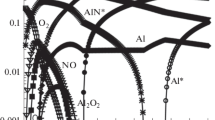Abstract
A physicomathematical model is developed, which describes propagation of detonation waves in a suspension of coal-dust particles in air or oxygen within the framework of the concepts of one-velocity, two-temperature continuum mechanics. The model is verified by available experimental data on the dependence of the detonation velocity on the particle concentration, on ignition delays behind shock waves, and on characteristic times of pyrolysis and combustion processes. Stationary detonation structures are analyzed. Formation and stable propagation of stationary detonation waves are demonstrated by means of numerical simulation of shock-wave initiation. Key words: shock waves, detonation, gas suspension, coal-dust particles, mathematical simulation.
Similar content being viewed by others
REFERENCES
A. A. Borisov, B. E. Gel'fand, S. A. Tsyganov, et al., “Ignition of dusts behind shock waves," Khim. Fiz., No. 8, 1127–1128 (1983).
V. M. Boiko, A. N. Papyrin, and S. V. Poplavskii, “Effect of volatiles on ignition delays in gas suspension of coal dust in shock waves," Fiz. Goreniya Vzryva, 27, No. 2, 101–111 (1991).
A. E. Medvedev, A. V. Fedorov, and V. M. Fomin, “Description of ignition and combustion of gas mixtures with solid particles by methods of the mechanics of continuous media," Combust. Expl. Shock Waves, 20, No. 2, 127–132 (1984).
M. A. Nettleton and R. Stirling, “The ignition of clouds of particles in shock-heated oxygen," Proc. Roy. Soc., A300, 62–77 (1968).
A. G. Abinov and A. M. Chekhovskikh, “Experimental study of detonation arising in explosions of methane and coal dust in mines," in: Detonation. Critical Phenomena. Physicochemical Transformations in Shock Waves [in Russian], Chernogolovka (1978), pp. 54–61.
V. A. Levin and Yu. V. Tunik, “Combustion of coal dust in oxygen with an admixture of a gaseous fuel," Dokl. Akad. Nauk SSSR, 276, No. 4, 834–839 (1984).
V. A. Levin and Yu. V. Tunik, “Detonation in a methane-air suspension of coal dust," in: Mechanics of Reacting Media and its Applications [in Russian] Nauka, Novosibirsk (1989), pp. 106–122.
V. A. Levin and Yu. V. Tunik, “Initiation of detonation combustion for coal dust in a methane-air mixture," Combust. Expl. Shock Waves, 23, No. 1, 1–5 (1987).
M. A. Nettleton and R. Stirling, “Detonation in suspensions of coal dust in oxygen," Combust. Flame, 21, 307–314 (1973).
M. Zalesinski and S. Wojcicki, “Mechanism of formation and propagation of detonation in a mixture of coal dust and gaseous oxidizer," in: Physics of Aerodisperse Systems (collected scientific papers) [in Russian], No. 18, Kiev, Odessa (1978), pp. 73–75.
D. H. Edwards, P. J. Fearnley, and M. A. Nettleton, “Detonation limits of clouds of coal dust in mixtures of oxygen and nitrogen," Combust. Expl. Shock Waves, 23, No. 2, 239–245 (1987).
J. Fangrat, W. Glinka, P. Wolanski, and M. Wolinski, “Detonation structure in organic dust-oxygen mixtures," Arch. Combust., 7, Nos. 3/4, 321–332 (1987).
A. V. Fedorov, V. M. Fomin, and T. A. Khmel', “Mathematical modeling of catastrophic explosions of dispersed aluminum dust," in: V. E. Zarko et al. (eds.), Prevention of Hazardous Fires and Explosions, Kluwer Academic Publ. (1999), pp. 287–299.
Yu. A. Gosteev and A. V. Fedorov, “Ignition of the gas-coal dust mixture. Pointwise approximation," Combust. Expl. Shock Waves, 37, No. 6, 646–654 (2001).
É. P. Volkov, L. I. Zaichik, and V. A. Pershukov, Modeling of Combustion of a Solid Fuel [in Russian], Nauka, Moscow (1994).
V. V. Koren'kov and V. N. Okhitin, “Numerical determination of effect of explosive density on parameters of air shock waves,"J. Appl. Mech. Tech. Phys., 24, No. 3, 403–406 (1983).
N. B. Vargraftik, Handbook on Thermophysical Properties of Gases and Liquids [in Russian], Fizmatgiz, Moscow (1963).
T. E. Wall and V. S. Gururajan, “Combustion kinetics and the heterogeneous ignition of pulverized coal," Combust. Flame, 66, 151–157 (1986).
P. A. Libby and T. A. Blake, “Theoretical study of burning carbon particles," Combust. Flame, 36, 139–169 (1979).
A. V. Fedorov and T. A. Khmel', “Interaction of detonation and rarefaction waves in aluminum particles dispersed in oxygen," Combust. Expl. Shock Waves, 33, No. 2, 211–218 (1997).
J. L. Montagne and M. Vinokur, “Comparative study of high resolution shock capturing schemes for a real gas," AIAA J., 27, No. 10, 1332–1347 (1989).
Author information
Authors and Affiliations
Rights and permissions
About this article
Cite this article
Fedorov, A.V., Khmel', T.A. Mathematical Simulation of Detonation Processes in a Coal-Particle Suspension. Combustion, Explosion, and Shock Waves 38, 700–708 (2002). https://doi.org/10.1023/A:1021152630365
Issue Date:
DOI: https://doi.org/10.1023/A:1021152630365



